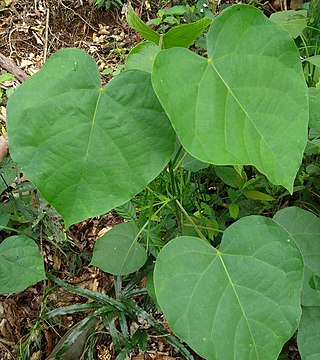
Mallotus is a genus of the spurge family Euphorbiaceae first described as a genus in 1790. Two species are found in tropical Africa and Madagascar. All the other species are found in East Asia, the Indian Subcontinent, Southeast Asia, eastern Australia, and certain islands of the western Pacific. The genus has about 150 species of dioecious trees or shrubs.
Colobocarpos is a monotypic plant genus of the family Euphorbiaceae. The sole species is Colobocarpos nanus. It is native to Laos and Northern Thailand.
Micrococca is a plant genus of the family Euphorbiaceae, first described in 1849. It is native to tropical Africa, Madagascar and Asia.

Sampantaea amentiflora is a plant species of the family Euphorbiaceae, first described as a genus in 1972. The genus Sampantaea is monotypic and found in Thailand and Cambodia.
Wetria is a plant genus of the family Euphorbiaceae, first described as a genus in 1858. It is native to Australia, New Guinea and Southeast Asia.
- Wetria australiensisP.I.Forst. - Papua New Guinea, Queensland
- Wetria insignis(Steud.) Airy Shaw - Thailand, Myanmar, Peninsular Malaysia, Borneo, Sumatra, Java, Lesser Sunda Islands, Philippines

Homonoia is a plant genus of the family Euphorbiaceae first described in 1790. These are rheophytes and usually found in groups at riverbanks in India, southern China, Southeast Asia, and New Guinea.
- Homonoia intermediaHaines - India
- Homonoia retusa Müll.Arg. - India, Vietnam
- Homonoia riparia Lour. - Guangxi, Guizhou, Hainan, Sichuan, Taiwan, Yunnan, Cambodia, India, Assam, Bhutan, Sri Lanka, Borneo, Java, Lesser Sunda Islands, Sulawesi, Sumatra, Maluku, Laos, Malaysia, Myanmar, Philippines, Thailand, Vietnam, New Guinea, Andaman & Nicobar Islands
Spathiostemon is a genus of trees in the Euphorbiaceae family. It is native to the Bismarck Archipelago, New Guinea, Wallacea and Southeast Asia. The trees grow between 10 and 20m tall, often in secondary forest. The wood is sometimes used.
Thyrsanthera is a genus of plants in the Euphorbiaceae first described as a genus in 1925. It contains only one known species, Thyrsanthera suborbicularis, native to Thailand, Cambodia, Vietnam, and possibly Laos.
Cladogynos is a genus of shrubs in the family Euphorbiaceae, first described as a genus in 1841. It contains only one known species, Cladogynos orientalis, native to Southeast Asia and southern China.
Pachystylidium is a genus of plant of the family Euphorbiaceae. It contains only one known species, Pachystylidium hirsutum, found in eastern India, Indochina, the Philippines, Sulawesi, the Lesser Sunda Islands, and Java.
Botryophora is a genus of plant of the family Euphorbiaceae first described as a genus in 1888. It contains only one known species, Botryophora geniculata, native to Thailand, Myanmar, Malaysia, Borneo, Sumatra, and Java.
Ptychopyxis is a genus of plant of the family Euphorbiaceae first described in 1861. It is native to Southeast Asia and New Guinea.
- Ptychopyxis arborea - Borneo
- Ptychopyxis bacciformis - Vietnam, Borneo, Sumatra, Philippines, W Malaysia
- Ptychopyxis caput-medusae - W Malaysia
- Ptychopyxis chrysantha - New Guinea
- Ptychopyxis costata - Borneo, Sumatra, W Malaysia
- Ptychopyxis glochidiifolia - Sumatra, Sarawak, Brunei, Kalimantan Timur
- Ptychopyxis grandis - Borneo
- Ptychopyxis javanica - S Thailand, Vietnam, W Malaysia, Borneo, Sumatra, Java
- Ptychopyxis kingii - W Malaysia, E Sumatra, Sarawak, Sabah
- Ptychopyxis plagiocarpa - S Thailand, S Myanmar

Endospermum is a genus of plants, under the family Euphorbiaceae and the monotypic subtribe Endosperminae first described as a genus in 1861 They are dioecious, rarely monoecious trees. It is native to E + S + SE Asia, Papuasia, Queensland, and certain islands of the W Pacific.

Austrobuxus is a genus of plants under the family Picrodendraceae first described as a genus in 1861. It is native to Southeast Asia, Papuasia, and Australia. The region with the highest diversity is New Caledonia.

Petalostigma is a genus of plants under the family Picrodendraceae and the monogeneric subtribe Petalostigmatinae, first defined by von Mueller in 1857. It is native to New Guinea and Australia. They are evergreen, dioecious shrubs or trees.

Agrostistachys indica is a species of plant in the family Euphorbiaceae, known in Singapore as the leaf litter plant. The species is widespread across much of Southeast Asia as well as New Guinea, India, and Sri Lanka.
Mallotus plicatus is a tree or shrub in the Euphorbiaceae family, in the Polyadenii section. It occurs in much of Mainland Southeast Asia. It is used for dyeing and in construction.
Mallotus floribundus is a tree in the family Euphorbiaceae, in the Stylanthus section, native to Southeast Asia, Wallaceae, New Guinea and the Solomon Islands.
Spathiostemon moniliformis is a plant that can grow as a shrub or a tree in the Euphorbiaceae family, Acalypheae tribe. It is endemic to southern/peninsular Thailand.
Pantadenia adenanthera is a shrub in the Euphorbiaceae family. It is found in parts of Southeast Asia. The species is used for its wood and edible fruit.






